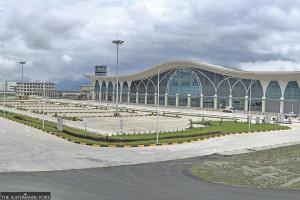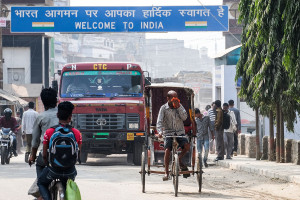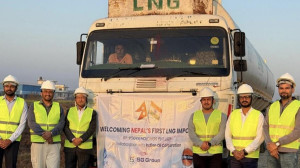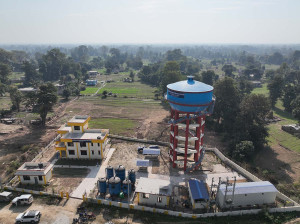Money
Locals halt 50MW Marsyangdi Besi Hydropower Project, citing threat to culture and environment
Construction suspended in Lamjung as residents launch ‘Save Marsyangdi River’ campaign. Developers say they are open to dialogue and design changes.
Aash Gurung
Construction of the 50MW Marsyangdi Besi Hydropower Project in Lamjung has come to a halt after locals opposed the plan, arguing that building a hydropower project on the Marsyangdi river would destroy human civilisation and eliminate water sources across the region.
The project, initially launched by Divya Jyoti Hydropower Limited, was later advanced by Api Power Company Limited after it acquired more than 51 percent of the shares.
The plan includes constructing a dam on the border between Belauti Bisauna in Ward 6 and Letefant in Ward 10 of Besisahar Municipality, and building a powerhouse in Saldanda, Ward 10.
Project manager Umesh Nepal said work was suspended after locals staged protests during the preparatory phase.
He said the board decided to hold consultations with residents and stakeholders before proceeding. “We were preparing for construction, but it had not begun. We want to resolve the issue through dialogue,” he said, urging locals not to obstruct development initiatives in their area.
According to Nepal, the project had already begun setting up the site and labour camps, and construction was scheduled to start officially on Friday. “All works have now been halted,” he said.
Residents of Besisahar have launched a “Save Marsyangdi River” campaign, collecting signatures, submitting petitions to the District Administration Office, and notifying the municipality.
Demonstrators even held a rally on Thursday, marching from Manange Chautara to Shera Chowk to demand the cancellation of the project.
Ram Bahadur Thapa, coordinator of the Marsyangdi Conservation Campaign, said their demand is non-negotiable. “No hydropower project should be allowed on the Marsyangdi river. If another project comes tomorrow, that also cannot be built. We will not compromise even an inch,” Thapa said. “We would rather give our lives than allow a project to be built on Marsyangdi.”
The Nepali Congress District Working Committee, Lamjung, has issued a press statement supporting the struggle committee.
Protesters argue that a hydropower project would damage religion, culture, traditions, and human civilisation, cause water sources to dry up, degrade natural beauty, and disrupt ecosystems. They say it would increase flood risks, destroy tourism and river-based livelihoods, kill aquatic life, and harm the landscape through blasting and heavy machinery.
Besisahar Mayor Guman Singh Aryal said previous local officials had granted project approval before federal restructuring, around 2008.
“I have clearly told the project developers that they cannot move ahead without resolving the issues and consulting the locals,” he said. “I have also told the protesting locals that once the federal government gives permission, we cannot stop it by ourselves. But we stand with our people.”
Chief District Officer Tokraj Pandey said residents submitted a memorandum requesting that authorities stop the project. “The project developers have not officially contacted us. We are reviewing the legal procedures,” he said.
The project received its survey licence from the Ministry of Energy, Water Resources, and Irrigation in October 2008. Its Environmental Impact Assessment (EIA) was approved in September 2017, and it signed a Power Purchase Agreement (PPA) with the Nepal Electricity Authority in August 2018.
Sanjiv Neupane, executive director of Divya Jyoti Hydropower Company Limited, said they conducted extensive environmental, social, and cultural studies and prioritised the development of affected areas.
“Some of the concerns raised by locals are valid. We are committed to minimising environmental impacts and ensuring the project benefits locals,” he said.
He stressed that they had no intention of damaging the river.
“We have followed all legal procedures. The country needs energy. Tourism and hydropower are what will make the country prosperous,” Neupane said, adding that they were exploring possible design adjustments. “We want to build the project while protecting the river, environment, and people’s lives.”
The project, estimated at Rs10 billion, will be financed with 30 percent equity and 70 percent bank loans. It aims to begin commercial electricity generation within two-and-a-half years, with power fed into the Nepal Electricity Authority’s Udipur substation.
17 projects are currently producing electricity in Lamjung, making it a hydropower hub.
Similarly, 11 hydropower projects are under construction in the district.
Among them, key projects include: Marsyangdi Bensi 50MW, Super Nyadi Hydro 40.27MW, Upper Khudi 21.21MW, Nyadi Fhidi 21MW, 13.42MW from Midimkhola-1, and Lower Nyadi 12.6MW.
It is estimated that 2,500 megawatts of electricity can be produced in Lamjung.




 11.12°C Kathmandu
11.12°C Kathmandu.jpg)













